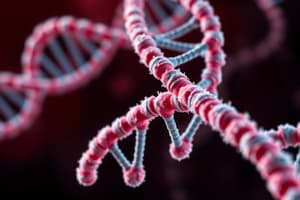Podcast
Questions and Answers
What is the primary reason cells do not express every gene at maximal levels?
What is the primary reason cells do not express every gene at maximal levels?
- Physical space limitations
- Energy and resource conservation
- Contradictory functions
- All of the above (correct)
At what level does gene regulation primarily occur in bacteria?
At what level does gene regulation primarily occur in bacteria?
- Alteration of DNA sequence
- Translational control
- Post-translational control
- Control of transcription (correct)
How do regulatory proteins typically bind to DNA?
How do regulatory proteins typically bind to DNA?
- Only as monomers
- Either as monomers or dimers (correct)
- In a linear fashion along the DNA strand
- Only when bound to other proteins
What differentiates repressors from activators in gene regulation?
What differentiates repressors from activators in gene regulation?
What role does the sensor kinase play in two-component signal transduction systems?
What role does the sensor kinase play in two-component signal transduction systems?
Which statement about transcription repressors is incorrect?
Which statement about transcription repressors is incorrect?
What do activators rely on to effectively bind to DNA sequences?
What do activators rely on to effectively bind to DNA sequences?
What describes the nature of regulatory proteins' interaction with DNA?
What describes the nature of regulatory proteins' interaction with DNA?
What role does the response regulator play once stimulated by the activated sensor kinase?
What role does the response regulator play once stimulated by the activated sensor kinase?
What happens to the lac operon in the absence of lactose?
What happens to the lac operon in the absence of lactose?
How does allolactose affect the function of LacI?
How does allolactose affect the function of LacI?
What is required for the maximum expression of the lactose operon?
What is required for the maximum expression of the lactose operon?
Which protein is responsible for transporting lactose into the cell?
Which protein is responsible for transporting lactose into the cell?
What are the components of the lac operon?
What are the components of the lac operon?
What effect does cAMP have during carbon starvation?
What effect does cAMP have during carbon starvation?
What is the function of β-Galactosidase in lactose metabolism?
What is the function of β-Galactosidase in lactose metabolism?
Flashcards
Sensor Kinase
Sensor Kinase
A transmembrane protein that detects environmental changes and transmits signals to the cytoplasm.
Response Regulator
Response Regulator
A cytosolic protein activated by a sensor kinase that binds to DNA to regulate gene expression.
Lactose Operon
Lactose Operon
A group of genes in bacteria that are responsible for lactose metabolism.
Lactose Permease (LacY)
Lactose Permease (LacY)
Signup and view all the flashcards
β-Galactosidase (LacZ)
β-Galactosidase (LacZ)
Signup and view all the flashcards
Lac Repressor (LacI)
Lac Repressor (LacI)
Signup and view all the flashcards
cAMP
cAMP
Signup and view all the flashcards
CRP (cAMP Receptor Protein)
CRP (cAMP Receptor Protein)
Signup and view all the flashcards
Gene Regulation
Gene Regulation
Signup and view all the flashcards
Transcription Repressors
Transcription Repressors
Signup and view all the flashcards
Transcription Activators
Transcription Activators
Signup and view all the flashcards
Ligand
Ligand
Signup and view all the flashcards
Operators
Operators
Signup and view all the flashcards
Inducer
Inducer
Signup and view all the flashcards
Two-Component Signal Transduction
Two-Component Signal Transduction
Signup and view all the flashcards
Study Notes
Chapter 10: Molecular Regulation
- Overview:
- Introduction to gene regulation
- Transcription repressors and activators
- The lactose operon
Introduction
- A bacterial genome encodes many different proteins
- Cells do not express all genes at maximum levels, this is due to:
- Physical space limitations
- Energy and resource conservation
- Contradictory functions
Mechanisms of Gene Regulation
- Microbes utilize various mechanisms to sense internal/external environments and synthesize specific proteins
- Gene regulation occurs at multiple levels including:
- Alteration of DNA sequence
- Control of transcription
- Control of mRNA stability
- Translational control
- Post-translational control
Transcription Repressors and Activators
- Transcription Initiation: Major control site in bacteria, often controlled by regulatory proteins.
- Regulatory Proteins:
- Bind to DNA at or near gene promoters
- Stimulate or inhibit RNA polymerase binding to promoter
- Interact with DNA's major groove, often forming dimers
- DNA Targets:
- Exhibit symmetry (inverted repeats)
- Regulatory proteins often bind as dimers (each monomer to one repeat sequence)
- Mechanisms:
- Intracellular changes detected by regulatory proteins binding specific low-molecular-weight compounds (ligands)
- Genes encoding regulatory proteins are transcribed separately from target genes
Sensing the Extracellular Environment
- Two-Component Signal Transduction Systems:
- Sensor Kinase: Membrane-bound enzyme, binds environmental signals and transfers a phosphate group from ATP to a target protein
- Sensory domain interacts with the environment, kinase domain inside the cell
- Response Regulator: Cytosolic protein, activated by sensor kinases binding to DNA, affecting gene expression
- Can either stimulate or repress gene expression
- Down-regulated by phosphatases removing the phosphate group
- Sensor Kinase: Membrane-bound enzyme, binds environmental signals and transfers a phosphate group from ATP to a target protein
The Lactose Operon
- Historical Context:
- 1961: Monod and Jacob proposed gene regulation in E. coli
- 1965 Nobel Prize for gene regulation work
- Lactose Metabolism:
- Disaccharide (glucose + galactose), carbon and energy source
- Requires:
- Lactose permease (LacY): Transports lactose into the cell
- β-Galactosidase (LacZ): Breaks down lactose into monosaccharides or rearranges it to allolactose
Regulation of the lac Operon
- Operon Structure:
- lacZ, lacY, lacA genes form an operon (regulated by a single promoter (PlacZYA) and operator sequences (lacO))
- Lactose repressor (LacI) is encoded by a regulatory gene upstream of the operon and constantly expressed
Lactose Presence
- Mechanism:
- In absence of lactose, LacI binds operators (lacO and lacOI), preventing RNA polymerase from initiating transcription.
- In presence of lactose, allolactose binds LacI, decreasing its affinity for the operator, allowing RNA polymerase to initiate transcription of lacZYA genes.
- cAMP and CRP
- Mechanism:
- cAMP accumulates when cell is starving for carbon and combines with cAMP receptor protein (CRP)
- Maximum lactose operon expression requires removing LacI and binding of cAMP-CRP complex to DNA sequence upstream of transcription start site
- cAMP-CRP complex activates RNA polymerase.
- Mechanism:
- Mechanism:
- Catabolite Repression: Catabolism of one nutrient (e.g., glucose) represses operon expression in favour of a more favourable nutrient (eg glucose)
- Diauxic Growth
- Biphasic growth curve of a culture growing on two carbon sources.
- Inducer Exclusion
- Glucose transport (phosphotransferase system (PTS)) inhibits LacY permease
- Prevents lactose from entering the cell and inducing the lac operon
- In absence of glucose, phosphorylated forms of glucose-specific IIAGlc and IIBGlc accumulate, allowing LacY to transport lactose and induce lac operon.
Studying That Suits You
Use AI to generate personalized quizzes and flashcards to suit your learning preferences.



